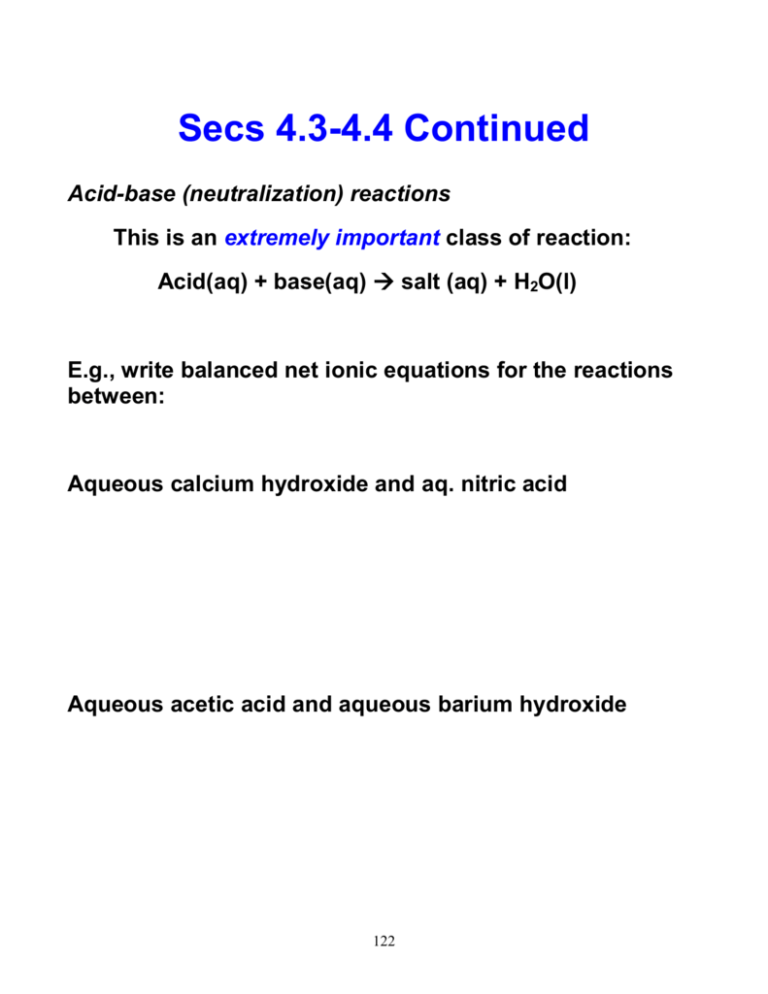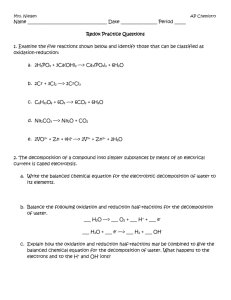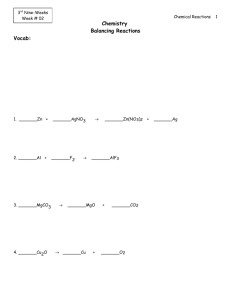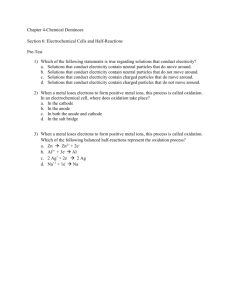Chapter 4 lecture 2
advertisement

Secs 4.3-4.4 Continued
Acid-base (neutralization) reactions
This is an extremely important class of reaction:
Acid(aq) + base(aq) salt (aq) + H2O(l)
E.g., write balanced net ionic equations for the reactions
between:
Aqueous calcium hydroxide and aq. nitric acid
Aqueous acetic acid and aqueous barium hydroxide
122
2. Neutralization reactions with gas formation
In general,
strong acid + metal { carbonates, bicarbonates, sulfide,
sulfites } salt + acid
Carbonates and bicarbonates will form H2CO3
Sulfides will form H2S
Sulfites will form H2SO3
The acids formed in solution decompose & give off gases, e.g.,
Na2CO3(aq) + HCl(aq) NaCl(aq) + H2CO3(aq)
then.....
H2CO3(aq) H2O(l) + CO2(g)
Write the balanced net ionic equation for this reaction!
123
Write balanced net ionic equations for:
ZnS(s) and HCl(aq)
Solid potassium sulfite and aqueous hydrochloric acid
124
4.4 Oxidation – Reduction (redox) reactions
oxidation: loss of ereduction: gain of ee.g., Ca(s) + 2H+(aq) Ca2+(aq) + H2(g)
Which species is oxidized? which is reduced?
Note that when something is oxidized, something
else is reduced!
Oxidation numbers: allow us to keep track of which
species is gaining/losing e- in redox reactions
An increase in oxidation number indicates that a
species is oxidized
A decrease in oxidation number means that a species
is reduced
Recall how to deduce charges in ionic compounds, e.g.,
BaCl2…….
We want a similar model for molecular compounds
125
Rules for assigning oxidation numbers
Oxidation number of an element in elemental form = 0
E.g., H2(g), F2(g), Na(s), I2(s)
Oxidation number of a monoatomic ion = its charge
E.g., K+, O2-, Cl-
E.g., what are the oxidation numbers of Fe and O in
Fe2O3?
What about a binary molecular compound, e.g., CO2?
Nonmetals: generally have negative oxidation numbers
Oxygen: usually -2 in both ionic and molecular
compounds (-1 in peroxides)
Hydrogen: +1 when bonded to a nonmetal, -1 when
bonded to a metal
Fluorine: always -1 in all compounds
Other halogens: generally -1 except when with
oxygen, then positive (e.g. Cl in ClO4-)
126
Sum of oxidation numbers=0 for a neutral compound, and
equals the overall charge for an ionic species
e.g., find the oxidation state of the underlined element in
P2O5; SnBr4; Na2SO3
How to use this?
E.g., Which element is oxidized and which is reduced in the
following reactions?
Cl2(aq) + 2NaI(aq) I2(aq) + 2NaCl(aq)
PbS(s) + 4H2O2(aq) PbSO4(aq) + 4H2O(l)
127
Oxidation of metals by acids and salts
Many metals react with acids to form salts and hydrogen
gas:
Metal(s) + acid(aq) salt(aq) + H2(g)
e.g., write a balanced equation for the reaction between
Fe(s) and sulfuric acid.
When a metal reacts with an acid, what is oxidized? what
is reduced?
128
Metals can also be oxidized by aqueous solutions of
various metal salts…..
e.g., Write a balanced equation for the reaction between
Fe(s) and nickel (II) nitrate to form solid nickel and iron (II)
nitrate.
Can we predict whether a certain metal will be oxidized by
acids or salts of other metals?
We list the metals in order of decreasing ease of oxidation
The easier a metal is oxidized (gives up electrons), the
more active the metal
129
This ordering is known as the activity series
The activity series is used to predict reactivity as follows:
Any elemental metal on the list can be oxidized by the ions
of elements below it
e.g., Will Cu react with Fe2+? What about Ag?
e.g., Will Cu react with an acid solution? What about Al?
Note that the group 1 and 2 elements are the most active –
why?
130
Problems du Jour
Classify each of the following substances as a
nonelectrolyte or strong/weak electrolyte in H2O
HF
NH3
Cu(NO3)2
Ni(OH)2
C2H5OH
131
Problems du Jour
Which element is oxidized and which is reduced in the
following reactions:
Ni(s) + Cl2(g) NiCl2(aq)
Fe2O3(s) + 3CO(g) 2Fe(s) + 3CO2(g)
Write balanced molecular and net ionic equations for the
reactions of
Aluminum with formic acid, HCHO2
Chromium with hydrobromic acid
132
Problems du Jour
Based on the activity series, what is the outcome of the
following reactions?
Al(s) + NiCl2(aq)
Mn(s) + HBr(aq)
Ag(s) + Pb(NO3)2(aq)
133







